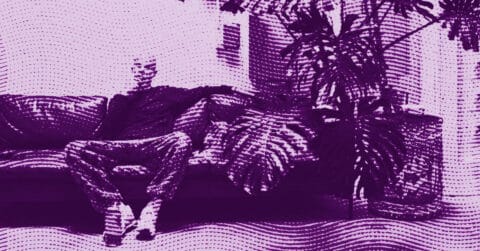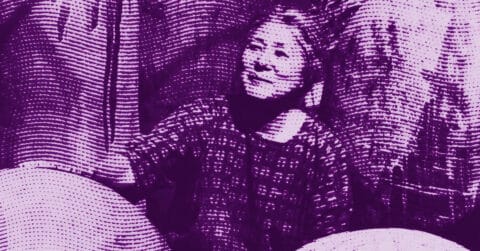Listen to me carefully, you bunch of snobs: Gilbert & George are not ordinary artists, and pretending to understand them through the conventional prism of contemporary art history would be as gross an error as judging a cathedral by the color of its stained-glass windows. This unlikely duo, formed in 1967 at Saint Martin’s School of Art, has methodically built a body of work that defies any hasty classification, any attempt to reduce it to a movement, a school, or a passing trend.
Gilbert Prousch, born in South Tyrol, Italy, in 1943, and George Passmore, born in Plymouth in 1942, have embodied an artistic singularity for over half a century that deserves rigorous attention. Their approach is anchored in a long temporality, almost architectural, where each work forms an additional stone in the edifice they patiently erect. The architectural dimension of their work is not a convenient metaphor but a profound structural reality. Their house on Fournier Street in Spitalfields, this 18th-century Georgian home where they have lived since 1968, is not simply a place of residence but the very crucible of their artistic practice. Architecture becomes for them language, method, philosophy. The meticulous restoration they undertook on this building, restoring its original decor, demonstrates a keen awareness of the relationship between structure and content, between form and existence. This house is not a set but an extension of their artistic body, a space where life and art fuse to indistinction.
The black grids that have structured their photomontages since the 1970s immediately evoke the ordering of medieval stained-glass windows, those fragmented compositions that tell sacred stories through colored panels. But where Gothic stained glass elevates the soul towards the divine, the grids of Gilbert & George bring it brutally back to the earthly, the corporeal, even the obscene. Their Pictures series, inaugurated in the early 1970s, imposes a rigorous compositional system where each work unfolds like an open window onto the London East End. This geometric structuring, far from being a simple aesthetic choice, establishes order in the chaos of urban life that they document with an almost manic constancy. The saturated, often garish colors, imprisoned behind these black bars, create a tension between containment and overflow, between the Apollonian of structure and the Dionysian of content. The architecture of their works mimics that of the city itself, with its windows, facades, spatial divisions organizing human proximity.
The sociological question runs through their work with an acuity that surprises, especially for artists often accused of frivolity. Gilbert & George do not merely observe their neighborhood; they turn it into a laboratory for studying contemporary social mutations. Their assertion that “nothing happens in the world that does not happen in the East End” [1] might seem presumptuous if it were not accompanied by a production of images that methodically document the social strata of this territory. London’s East End, with its history of successive immigration, endemic poverty, and rampant gentrification, indeed offers a concentration of the tensions that traverse Western metropolises. The artists position themselves there as ethnographers in three-piece suits, collecting the detritus of urban modernity: nitrous oxide cartridges, graffiti, sex worker advertisements, sensationalist newspaper headlines. This accumulation is not gratuitous but follows an almost scientific methodology. Each element taken from their immediate environment becomes a symptom, a clue to the class, race, and gender relations that structure British society.
Their use of language, notably in series such as Ages from 2001 or the Jack Freak Pictures from 2009, reveals a fine understanding of the mechanisms of symbolic domination. By reproducing male prostitution ads, they starkly expose the commodification of bodies in the neoliberal economy. By collecting the hysterical headlines of the Evening Standard, they lay bare the production of fear and resentment that fuels populism. The obsessive repetition of the words “Murder,” “Victim,” “Gangs” in their compositions highlights the ideological function of media discourse, which constructs a reality where violence becomes the dominant mode of apprehending the social. Gilbert & George do not explicitly denounce these mechanisms; their displayed neutrality shields them from any didacticism, but their montage produces critical distancing. The viewer is confronted with the raw materiality of social language, decontextualized and reified within the artwork’s space.
The question of social class quietly permeates their practice. Their clothing uniform, the outdated suits they have worn since The Singing Sculpture in 1969, constitutes a sociological gesture as much as an aesthetic one. The suit historically represents the clothing of petty-bourgeois respectability, the attire of the clerk, the office worker, the lower-level civil servant. By daily confining themselves in it, Gilbert & George perform an ambiguous class identity, neither proletarian nor aristocratic, which exactly corresponds to their position in the artistic field. They claim popular accessibility with their slogan “Art for All” [2], yet produce works sold at gold prices to international collectors. This contradiction is not hypocrisy but an honest reflection of the impossible position of the contemporary artist, caught between democratic aspiration and integration into the luxury market. Their neighborhood of Spitalfields embodies this tension: a former working-class territory of the textile industry, it has become one of London’s most gentrified sectors, where Georgian houses reach several million pounds. Gilbert & George inhabit this contradiction both physically and symbolically.
Their treatment of religion as a social institution is particularly interesting. The works from the Sonofagod Pictures series of 2005 do not simply blaspheme for the sake of shock. They question the persistence of religious fact in secularized societies and the way in which sacred symbols continue to exert a grip on the collective imagination. By juxtaposing Christian crosses, Islamic motifs, and their own bodies in Christ-like postures, they highlight the universal anthropological function of religion while demystifying its transcendental claims. Religion appears as one system of signs among others, no more nor less legitimate than advertising or pornographic language. This generalized equivalence of symbolic systems, characteristic of the postmodern condition, finds a particularly explicit expression in their work.
The racial question, ever-present in their work from the 1980s and 2000s, raises ambiguities that the artists embrace with a form of calculated provocation. Titles like Paki, used to designate the portrait of an Asian man, have sparked accusations of racism, accusations they dismiss with a wave of the hand by invoking their function as a social mirror. They argue that they do not create racism; they document it. This stance of ethnographic neutrality is obviously problematic, as it obscures the fact that even the critical reproduction of racial stereotypes contributes to their circulation. Nevertheless, their insistence on representing the ethnic diversity of the East End, giving visibility to marginalized populations, participates in a form of inclusivity, albeit a clumsy one. Their latest works, exhibited until January 11, 2026, at the Hayward Gallery in London, continue to question the identity fault lines that run through post-Brexit British society, a society they have observed for more than half a century with admirable consistency.
Gilbert & George’s artistic gesture fundamentally consists of transforming their very existence into living sculpture. This decision made at the end of the 1960s to never appear separately, to constantly wear the same type of suit, to refuse the distinction between working time and private life, amounts to a radicality whose demands are hard to fully grasp. They have literally constructed themselves as monuments, public figures whose artistic identity supersedes all personal identity. This self-monumentalization finds its logical culmination in the opening in 2023 of the Gilbert & George Centre on Heneage Street, a space dedicated exclusively to their work, a foretaste of a mausoleum where their memory will be preserved after their death. For death now lurks in their recent compositions. The 2023 series The Corpsing Pictures shows them lying on bones, dressed in blood-red suits. Over eighty years old, they face their finitude with the same absence of affectation that they have applied to all other subjects.
Their relationship to sexuality deserves close attention. Married civilly in 2008 after forty years of living together, they made their homosexual relationship a constitutive element of their work long before it became socially acceptable. The Naked Shit Pictures of 1994, which show them naked amid representations of excrement, affirm the carnal, bodily, trivial dimension of human existence. They reject the romantic sublimation of love as well as sexuality, preferring to show them in their prosaic materiality. This disenchanted approach may seem cynical, but it also carries a form of tenderness. Their assertion that their works are “a kind of visual love letter from us to the viewer” [3] suggests that behind the provocation and obscenity lurks a desire for human connection, a will to share an experience of the world without disguise or lies.
The work of Gilbert & George resists any easy recuperation. Self-proclaimed conservatives, admirers of Margaret Thatcher, supporters of Brexit and the monarchy, they defy the political expectations of the generally progressive contemporary art milieu. This heterodox position earned them hostility from part of the criticism, who accuse them of complacency towards reactionary forces. Yet their works on fascism or homophobia testify to an unequivocal commitment against oppression. This apparent contradiction chiefly reveals the poverty of binary political categories in apprehending the complexity of reality. Gilbert & George evade the boxes, and it is precisely this that makes their work necessary. They remind us that social life cannot be reduced to slogans, that individuals are not ideological abstractions but flesh-and-blood beings traversed by contradictions.
Their legacy far exceeds the frame of British art history. They have influenced generations of artists, from Kraftwerk, who drew on their appearance to create his robotic aesthetic, to Grant Morrison, who parodied them in his comic book series The Filth. Their exceptional longevity, more than fifty-five years of uninterrupted collaboration, constitutes in itself a remarkable performance in an art world characterized by ephemerality and the race for novelty. They have methodically built a cathedral-like oeuvre, stone by stone, image by image, with monastic discipline. This patience, this faithfulness to a vision, this obstinacy in digging the same furrow decade after decade commands respect, even if some aspects of their work can be contested.
At the end of this journey into the world of Gilbert & George, one thing becomes clear: their work does not allow itself to be tamed by conventional analytical frameworks. It demands that one approaches it with the tools of architecture to understand its structure, with those of sociology to grasp its anchoring in the real, with those of anthropology to appreciate its documentary dimension. But it also requires accepting its irreducible share of mystery, that opaque zone where two lives have merged into a single artistic entity whose intimate logic necessarily eludes us. Their home on Fournier Street, temple and laboratory, archive and sanctuary, will become after their passing a pilgrimage site for those seeking to unravel the secret of this fusion. But perhaps this secret does not exist, perhaps Gilbert & George simply chose to live their art rather than produce it, and that original decision already contains the key to their enigma. In an era saturated with theoretical discourses and conceptual justifications, they offer the rare spectacle of an artistic practice that is self-sufficient, that does not need to be translated or explained because it is there, massive, unavoidable, sometimes irritating, but undeniably alive. And perhaps that is their ultimate victory: having managed to survive all fashions, all movements, all theories, stubbornly remaining themselves, two men in suits watching the world pass by from their Spitalfields street, collecting its debris to make cathedrals of light and mud.
- Anna van Praagh, “Gilbert and George: ‘Margaret Thatcher did a lot for art'”, The Daily Telegraph, July 5, 2009
- Slogan adopted by the artists from their beginnings, mentioned notably in Wolf Jahn, The art of Gilbert & George, or, An aesthetic of existence, Thames & Hudson, 1989
- Quote from the artists reported in “Gilbert & George deshock at Rivoli”, ITALY Magazine, archive of January 28, 2013
















